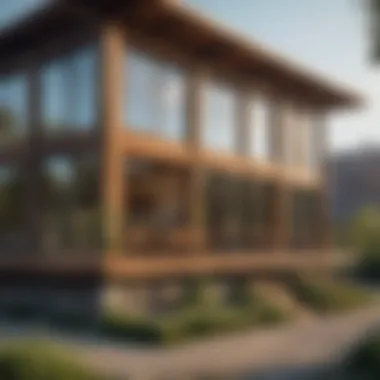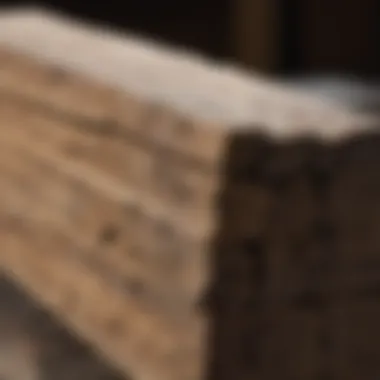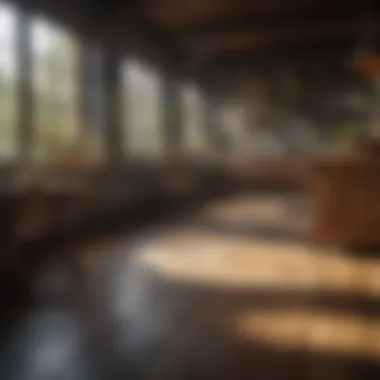The Significance of Rhine Reclaimed Wood in Sustainable Practices


Intro
The topic of reclaimed wood is becoming increasingly significant in sustainable architecture and agriculture. Among the various sources of reclaimed wood, Rhine reclaimed wood stands out due to its unique characteristics and environmental benefits. This article aims to explore the various aspects of Rhine reclaimed wood, highlighting its role in promoting sustainability in these fields.
Topic Overview
Definition and Importance
Rhine reclaimed wood refers to timber salvaged from structures and products that were previously used, primarily from the Rhine River region. Its importance lies in its ability to reduce deforestation, conserve natural resources, and minimize waste by repurposing existing wood. This approach reduces the carbon footprint associated with new timber production, making the use of Rhine reclaimed wood a crucial element in sustainable practices.
Brief History and Evolution
The practice of using reclaimed wood dates back centuries, but it has gained more attention in recent years due to increased awareness of environmental issues. Initially, wood was reclaimed from demolished buildings and ships. The Rhine River area has a rich history of timber production, and as industries evolved, the demand for sustainable materials rose, thus creating a niche for reclaimed wood. Over time, it has transitioned from being an alternative to new timber into a desirable, sustainable resource found in trendy buildings and rural agricultural setups alike.
Key Techniques and Innovations
Sustainable Farming Practices
Utilizing Rhine reclaimed wood in agricultural settings not only promotes sustainability but also encourages innovative farming techniques. Landowners and farmers are increasingly incorporating reclaimed wood into structures like barns and greenhouses. This not only reduces their expenses but also provides a rustic aesthetic that appeals to eco-conscious consumers.
Advanced Agronomic Technologies
The integration of reclaimed wood into modern agronomy is also noteworthy. Techniques such as using reclaimed wood in biochar production can enhance soil health. Additionally, using reclaimed wood for creating sustainable fencing and planting structures can significantly lower the environmental impact and costs of traditional farming methods.
Practical Applications
Step-by-Step Guides
When utilizing Rhine reclaimed wood, several best practices can ensure optimal results.
- Source Wisely: Ensure the wood is structurally sound and free from contamination.
- Treatment: Treat the wood with appropriate preservatives to extend its life.
- Design: Plan your structures ensuring maximum utility and aesthetics.
- Installation: Follow best practices for construction, as reclaimed wood can vary in size and texture.
Case Studies or Real-World Examples
One significant example is the transformation of old factory buildings along the Rhine into modern homes and community spaces. These projects not only preserve the historical significance of the materials but also embody eco-friendly living. Furthermore, successful showcases in local markets demonstrate how reclaimed wood can be utilized in creating functional, sustainable structures while attracting eco-conscious consumers.
"Reclaimed wood, particularly from the Rhine region, is not just about sustainability; it’s a testament to history and innovation in modern architecture and farming."
Prelude to Rhine Reclaimed Wood
Rhine reclaimed wood is not just a resource; it embodies a commitment to sustainability and heritage. This section introduces the pivotal role that this type of wood plays within sustainable practices. By understanding how reclaimed wood contributes to ecological balance, farmers and enthusiasts can make informed choices that align with modern sustainability goals.
Defining Reclaimed Wood
Reclaimed wood refers to timber that has been previously used in construction, renovation, or manufacturing and is repurposed rather than discarded. This practice supports environmental stewardship by minimizing deforestation and reducing waste. Reclaimed wood can originate from various structures, including old barns, factories, and even schools. The definition emphasizes its value as a sustainable alternative to new lumber, which often comes from logging practices that may harm ecosystems.
When considering reclaimed wood for agricultural or design projects, it is essential to recognize the unique character and history that it carries. Each piece tells a story, reflecting the environmental and social narratives of its origins. Therefore, reclaimed wood is not merely a material; it represents a conscious choice towards sustainability, decreasing the demand for new timber and promoting a cycle of reuse.
The Rhine River: A Historical Perspective
The Rhine River has a rich and complex history, influencing trade, culture, and architecture in Europe. Stretching over 1,230 kilometers, it has served as a vital transport route since ancient times. Many structures that line its banks were built using local timber, which over the years has been replaced or abandoned. As communities evolved, the wood from these structures became a potential resource for reclamation.


Historically, reclaimed wood from the Rhine has found its way into both local and global markets, contributing to sustainable building practices that honor tradition while addressing contemporary environmental concerns. The heritage of the Rhine adds intrinsic value to the reclaimed wood, making it sought after for applications in both architecture and design.
"Reclaimed wood is more than just a material; it’s an embodiment of history, sustainability, and craftsmanship."
Understanding this historical aspect enriches the narrative of Rhine reclaimed wood. For those engaged in sustainable agriculture, the significance of this resource lies not only in its environmental benefits but also in its historical legacy. By choosing Rhine reclaimed wood, farmers and designers participate in a practice that respects the past while fostering a sustainable future.
The Process of Reclamation
The process of reclaiming wood from the Rhine is an essential phase in promoting sustainability in architecture and design. This process not only involves recovering wood that has historical significance but also focuses on minimizing waste and maximizing resource use. The reclaimed wood, often rich in character and potential durability, embodies a narrative that can enhance any structure. Understanding this process reveals the comprehensive benefits to the environment and society.
Sourcing Materials from the Rhine
Sourcing materials from the Rhine River presents unique opportunities. Historically, wood collected from the river has played a significant role in local construction. There are vast amounts of timber that have sunk or been discarded into the river over many years. Retrieving this wood can help reduce the demand for new timber, ultimately preserving the surrounding forests. The geographical proximity of the Rhine to various communities also finalizes the supply-chain efficiency which can reduce carbon emissions associated with transport.
Several types of wood can be sourced from this region including oak, pine and beech. Each of these types brings different attributes to the final reclaimed product. Their characteristics can tailor the finished wood to specific applications, from furniture to flooring and structural elements.
Preservation Techniques
Preserving reclaimed wood is crucial for ensuring its integrity and usability in new applications. Techniques vary widely, focusing on both the physical and chemical treatment of the wood. One common method involves drying the wood to eliminate moisture, which can lead to warping or mold growth if left untreated. This process often entails using heat or air drying methods.
Another important preservation technique includes the elimination of any biological hazards. Pests, fungi, or any contaminants must be removed or treated before the wood can be safely used. Some companies use eco-friendly treatments which are less harmful to the environment, aligning with the ethos of sustainable practices. Implementing these techniques not only prolongs the lifespan of the reclaimed wood but also ensures it meets safety standards for builders and consumers alike.
Quality Assessment of Reclaimed Wood
Quality assessment of reclaimed wood is fundamental in maintaining high standards in sustainable building materials. Inspecting for durability and visual defects is just the start. Each piece must be evaluated carefully to ensure it can perform under new structural demands.
Following visual inspection, tests such as density checks, moisture content analysis, and structural integrity assessments are often conducted. These evaluations confirm if the wood can hold up to expected loads and pressures in its new role. Additionally, it is vital to check for any potential hazards rooted in its history, such as chemical treatments that may have been applied decades ago. Relying on certified third-party inspectors can ensure a high standard is met consistently.
Reclaimed wood undergoes a rigorous process of sourcing, preservation, and quality assessment, making it an ideal choice for sustainable architecture.
In sum, the process of reclaiming wood from the Rhine involves intricate steps that underscore its significance. From sourcing to its quality assurance, reclaimed wood serves many purposes while promoting sustainable construction practices.
Environmental Impact of Reclaimed Wood
The relevance of reclaimed wood in sustainable practices cannot be overstated. These materials, particularly from the Rhine region, play a crucial role in mitigating adverse environmental impacts. By understanding how reclaimed wood influences overall sustainability, we can appreciate its significance in today's ecological landscape.
Carbon Footprint Reduction
One of the primary benefits of using Rhine reclaimed wood is its potential for significantly reducing carbon footprints. Traditional logging processes release carbon dioxide into the atmosphere. However, reclaimed wood has a distinct advantage: it utilizes timber that has already secured carbon for years. By repurposing this wood, we effectively keep carbon stored, thus decreasing greenhouse gas emissions.
Additionally, the energy required for manufacturing new wood products is often substantial. The production processes can involve intensive machinery and transportation. Conversely, reclaimed wood generally requires less energy for processing, allowing sustainable practices to be more feasible. The transition away from new timber sources not only lessens this energy consumption but also makes it easier to maintain a balanced ecosystem.
Biodiversity Conservation
Reclaimed wood contributes positively to biodiversity. Forests are vital ecosystems that host diverse species. When new timber is harvested, destruction of habitats often occurs. By adopting reclaimed wood in construction and design, forests face less pressure from logging. This allows wildlife to remain undisturbed while maintaining ecosystem balance.
In the case of Rhine timber, it often carries unique histories. By preserving and utilizing wood recovered from the river’s historic infrastructure, we contribute to a narrative that honors both our environment and our heritage. Such conservation efforts resonate with consumers who value ecological preservation. They encourage responsible sourcing, thus fostering a more sustainable future.
Synergy with Sustainable Agriculture
The intersection of reclaimed wood and sustainable agriculture reveals opportunities worth exploring. Agriculture is deeply intertwined with environmental health. By integrating Rijn reclaimed wood into agricultural practices, farmers can create eco-friendly structures. Examples include barns, storage facilities, and fencing made of reclaimed wood.
Using such materials not only supports sustainability but also can potentially lower costs related to construction. This shift drives forward the sustainability agenda in farming, as it aligns with practices aimed at preserving natural resources. Furthermore, the aesthetics of reclaimed wood can enhance the appeal of agricultural settings, showcasing a commitment to environmentally-conscious growth.


Advantages of Using Rhine Reclaimed Wood
The utilization of Rhine reclaimed wood presents numerous significant benefits that underscore its relevance in sustainable practices today. As the demand for environmentally responsible materials grows, this wood offers a blend of durability, aesthetic appeal, and economic value that appeals to both builders and consumers. Across various applications, the adoption of Rhine reclaimed wood represents a commitment not just to aesthetic beauty, but also to environmental stewardship.
Durability and Longevity
Rhine reclaimed wood is known for its remarkable durability. This resilience stems from its history; the wood often originates from old growth forests, where trees were allowed to mature for many decades. Consequently, the fibers in the wood are tightly packed, which contributes to its strength.
Unlike new wood, which may be susceptible to warping and checking, reclaimed wood has already endured natural conditions, making it a stable choice for construction. This longevity translates to reduced need for replacements and repairs, making reclaimed wood a smart choice for sustainable building practices. Furthermore, the environmental benefits of sourcing such material help in the larger narrative of conserving forests.
Aesthetic Appeal
In addition to its structural advantages, Rhine reclaimed wood offers unique aesthetic appeal. Each plank tells a story through its knots, grain patterns, and coloration that cannot be replicated with new wood. This individuality makes it highly sought-after in architectural designs and furniture making.
Using reclaimed wood can enhance the character of spaces, adding warmth and a sense of history to modern designs. Homeowners and designers alike appreciate this blend of old and new, which creates a distinctive atmosphere in any setting. As people gravitate towards eco-conscious choices in their homes, the natural beauty of Rhine reclaimed wood becomes a valuable asset in crafting personalized environments.
Cost Efficiency in Long-term Use
The cost efficiency associated with Rhine reclaimed wood can be observed from multiple perspectives. Initially, the price may appear higher compared to standard new lumber. However, when one factors in the longevity and potential maintenance costs associated with new wood, the financial argument shifts dramatically. Wooden structures made with Rhine reclaimed wood often require less frequent repairs or replacements, leading to savings over time.
Moreover, there are often financial incentives associated with using reclaimed materials, such as tax credits and sustainability grants. Businesses and individuals are increasingly recognizing the cost benefits of integrating reclaimed wood into their construction and renovation projects.
"Investing in Rhine reclaimed wood is not just an investment in beauty; it’s a commitment to sustainability and future savings."
Ultimately, the advantages of Rhine reclaimed wood extend beyond traditional measures of value. It is a material that embodies resilience, beauty, and economic sensibility, fitting into a broader eco-friendly lifestyle that appeals to progressive builders and consumers.
Applications of Rhine Reclaimed Wood
Rhine reclaimed wood has gained attention not only for its sustainability but also for its diverse applications in multiple fields such as architecture, furniture making, and landscaping. Each application harnesses its unique properties while contributing to eco-friendly practices. Understanding these applications highlights why reclaimed wood is a significant player in modern sustainable initiatives.
In Architecture and Design
The use of Rhine reclaimed wood in architecture represents an intersection of tradition and innovation. Architects prefer this material for its durability and aesthetic appeal. Structures made with reclaimed wood often exhibit a character that new materials lack. When used in flooring, wall panels, or beams, this wood tells a story through its unique grain patterns, appealing especially to those interested in a sustainable lifestyle.
- Environmental Benefits: Utilizing reclaimed wood reduces the demand for new lumber, directly contributing to forest conservation. This approach minimizes deforestation while promoting biodiversity.
- Regulatory Considerations: Many local building codes favor or even incentivize the use of reclaimed materials for sustainable construction, reflecting a shift towards more eco-friendly practices.
Architects can seamlessly integrate these materials into various styles, from rustic to modern, making Rhine reclaimed wood a versatile choice. Its availability aids in meeting the growing consumer demand for sustainable building solutions.
Furniture Making
In furniture making, Rhine reclaimed wood provides artisans and manufacturers with an opportunity to create unique and sustainable pieces. Each item crafted from this wood carries an individuality that mass-produced furniture cannot replicate.
- Durability: Furniture made from reclaimed wood is often more durable than new wood. This resilience makes it a sound investment for consumers.
- Craftsmanship: Artisans can use reclaimed wood to display their skills in carpentry. The imperfections and characteristics of the wood lend themselves to artistry in design, making each piece a conversation starter.
The market for reclaimed wood furniture is increasing, signs of a shift towards valuing craftsmanship over mass production. Customers are increasingly aware of the benefits, combining aesthetics with eco-consciousness.
Landscaping Uses
Landscaping is another area where Rhine reclaimed wood finds significant application. It can be utilized in various outdoor settings, providing both functional and decorative elements.
- Garden Beds: Reclaimed wood can be used for raised garden beds, providing a sustainable option for urban gardening. Gardeners can cultivate plants in an environmentally friendly way while reducing waste.
- Fencing and Decking: Many choose reclaimed wood for fences and decks. Its weathered look blends nicely with natural environments, often appealing to homeowners who value rustic aesthetics.


Using reclaimed wood in landscaping contributes to reducing waste, creating outdoor spaces that are not only beautiful but also environmentally friendly. The versatility of this material allows it to be repurposed easily in many other ways.
"Using reclaimed wood is more than a trend—it's a commitment to sustainability and craftsmanship. The potential for creativity in its application is limitless."
Challenges of Using Reclaimed Wood
The use of reclaimed wood, especially from the Rhine, presents numerous advantages. However, it is not without its challenges. Understanding these challenges is vital for practitioners in agriculture and design who aim to incorporate this material sustainably. The issues often revolve around the supply chain and quality control, both of which must be navigated carefully to maximize the benefits of reclaimed wood.
Supply Chain Limitations
One of the significant challenges in utilizing Rhine reclaimed wood is the intricacies within the supply chain. This limitation can stem from several factors:
- Availability: The reclamation of wood relies on the availability of discarded or unused timber. This naturally varies depending on seasonal conditions and economic factors affecting timber production.
- Logistics: Transporting reclaimed wood can become a logistical nightmare. Shippers must consider the size and weight of the materials, which can complicate their distribution, especially in regions where transport infrastructure may be underdeveloped.
- Partnerships: Sourcing quality reclaimed wood often requires establishing partnerships with local reclaimers. A reliable network of suppliers can be difficult to maintain, leading to inconsistencies in material availability.
Overall, the supply chain for Rhine reclaimed wood necessitates a careful balance between demand and logistics to ensure that the material remains a viable and sustainable resource.
Quality Control Issues
Quality control represents another substantial hurdle in the reclaimed wood market. Unlike new timber, which can be standardized, reclaimed wood comes with a variety of challenges:
- Inconsistency: Variability in quality is inherent in reclaimed wood. Factors such as age, previous use, and the environmental conditions where the wood was sourced can affect its integrity, resulting in differences in durability and appearance.
- Inspection: Proper inspection is crucial to ascertain the quality of reclaimed wood. This requires skilled labor capable of identifying defects, such as rot or insect damage. Without sufficient expertise in quality inspection, end-users may face significant risks.
- Treatment Protocols: The history of the reclaimed wood can include exposure to chemicals or treatments that may not align with current sustainable practices. Ensuring that all materials are safe for intended use is a critical component of quality control.
Control measures are essential to guarantee the reliability and sustainability of reclaimed wood. Addressing these quality issues helps practitioners make informed decisions when choosing materials for their projects.
Future Prospects of Rhine Reclaimed Wood
The potential for Rhine reclaimed wood in the sustainable industry continues to expand. As awareness about environmental issues grows, the interest in reclaimed materials like those from the Rhine River is increasing. This focus is not only on aesthetics or durability but also on the positive impact on ecological systems. Understanding the future prospects of this resource can provide insights for farmers and enthusiasts toward better practices in agriculture and design.
Trends in Sustainable Building
Sustainable building is seeing a shift toward more eco-friendly materials, and Rhine reclaimed wood is at the forefront of this trend. Architects and builders are prioritizing materials that reduce waste and carbon footprints. This wood, which carries a history, offers a unique character to projects, attracting those who wish for both style and substance. Use of reclaimed wood in building can radically lessen the need for new timber, preserving forests and reducing deforestation impacts.
Some notable trends include:
- Increased Demand: Projects using reclaimed wood are drawing interest from both residential and commercial sectors.
- Eco-Certifications: Many builders seek certifications that adhere to sustainability standards. Materials like Rhine reclaimed wood can aid in achieving these.
- Hybrid Designs: Combining reclaimed wood with modern materials is increasingly popular, blending the old with the new, creating unique designs.
These trends illustrate a growing recognition of sustainability in the construction and design fields. They emphasize not just the environmental benefits but also the narrative and artistry present in reclaimed materials.
Innovations in Materials Science
Innovations in materials science are pivotal for enhancing the properties and usability of reclaimed wood. Research and advancements in treatment techniques are making reclaimed wood more appealing for various applications. These innovations can ensure that the wood is resistant to pests, rot, and decay, addressing some of the concerns associated with using older materials.
Key aspects of innovation include:
- Enhanced Durability Treatments: New chemical and physical treatments can extend the lifespan of reclaimed wood, making it competitive with new materials.
- Sustainability Practices: Companies are developing processes to reclaim wood more effectively, reducing time and resource requirements.
- Design Flexibility: Techniques that allow for the reshaping and repurposing of reclaimed wood are expanding the options available for builders and designers.
The focus on innovation will undoubtedly shape the future of Rhine reclaimed wood, ensuring that it remains relevant and widely used as sustainability continues to be a priority in building and design industries.
"The future of construction lies in utilizing materials that tell a story while also preserving our environment."
Ending
The Role of Rhine Reclaimed Wood in Modern Sustainability
Rhine reclaimed wood serves multiple roles in the realm of modern sustainability. Firstly, it emphasizes the potential of reusing existing resources rather than relying on new timber production. This aspect is significant as it directly impacts deforestation rates and promotes biodiversity conservation. By utilizing wood sourced from the Rhine River, a system that has historical importance, practitioners can contribute to reducing the carbon footprint associated with lumber harvesting.
Moreover, reclaimed wood is often richer in character and quality compared to newly sourced timber. Its unique history and patina add aesthetic value to architectural designs and furniture, appealing to consumers who favor distinctive and personalized features in their environments. The durability of Rhine reclaimed wood ensures that structures built with it will endure, reducing the need for frequent replacements and repairs.
Furthermore, this resource aligns well with current trends in sustainable building and architectural practices. As more industries embrace environmentally friendly methods, Rhine reclaimed wood emerges as a preferred choice for structures aiming for LEED certification or similar accolades. With an increasing demand for sustainable materials, its role in modern architecture will only grow, making it an integral part of eco-conscious design.



